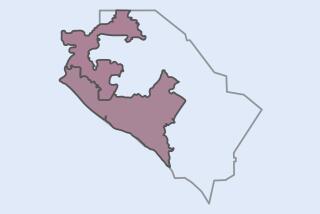Incumbents Hope for Best as Districts Are Redrawn
- Share via
Although Democratic Party leaders in Sacramento have finally released their proposals for new legislative boundaries, Curtis Tucker Jr. is still unsure about the future shape of his Inglewood-based Assembly district.
Under one of two Assembly district plans unveiled by Democrats this week, Tucker’s heavily minority district would reach into the Westside. Under the other, the Democratic lawmaker’s turf would extend instead into the South Bay’s beach cities.
Faced with predictions that either proposal will be opposed by Republicans and minority groups and challenged in court, Tucker says his attitude is decidedly wait-and-see.
“As long as my house is in the district, I’ll worry about everything else later,” the two-term assemblyman said Wednesday.
With the rule of confusion in Sacramento these days, it is still too early to tell exactly how the South Bay will be affected by reapportionment, the process in which political boundaries are realigned every decade to account for population shifts.
So far, only one redistricting proposal has been drafted on which leaders from both parties agree--a reapportionment plan for the state Senate. Drafted jointly by the Senate’s Democratic and Republican party leaders, the plan would mean major changes for South Bay districts--among them, to shift the 30th Senate District now represented by Ralph C. Dills (D-Gardena) out of the region.
But details about the Legislature’s plans for South Bay Assembly and congressional districts are more elusive. In the Assembly, Speaker Willie Brown (D-San Francisco) this week proposed the pair of alternative plans--both of which are subject to change before the Legislature’s scheduled recess at midnight Friday.
The separate plans, Brown said, are based on different assumptions about which Democratic incumbents will decide to run for Congress and which will run for re-election to the Assembly. Although the proposals do not contain clear information on boundaries, South Bay assemblymen say both plans would preserve their political power bases.
The 51st Assembly District of Gerald Felando (R-San Pedro) would include a larger portion of San Pedro than it does now, Felando says. Dave Elder (D-San Pedro) says his 57th District would wind up losing part of San Pedro and gaining portions of Long Beach.
Richard Floyd (D-Carson) says his 53rd District would take in the Lennox area and El Segundo, both of which are now represented by Tucker. In the process, the share of Latinos in Floyd’s territory, which also includes Carson, Gardena, Hawthorne and Lawndale, would grow to more than 36% from the current 29%, pushing the district’s minority population past the 70% mark.
Tucker’s district--whether it is extended into the Westside or into the beach cities--would include a larger share of Anglos than it has now but would still remain more than 60% minority.
Figures supplied with each of the two plans show that in all of the proposed South Bay Assembly districts, incumbents would continue to enjoy voter registration edges favoring their party. The majorities would range from a 64% share of Democratic voters in Tucker’s 50th District to a 52% majority of Republicans in Felando’s district.
Floyd on Wednesday said Democratic assemblymen in the South Bay have no major quarrels with their leadership’s proposals. But in an exchange with Elder on the Assembly floor Tuesday, Floyd indicated he is always prepared for changes.
After Elder noted that lawmakers are quick to check whether their homes are in the proposed districts, Floyd shot back: “Why do you think I have a mobile home?”
Congressional redistricting proposals released this week by California’s Democratic congressmen did not include detailed geographic or demographic information. But the most significant change in the offing is the planned “collapse” of the district of Mel Levine (D-Santa Monica), who is expected to run for the U.S. Senate. Manhattan Beach and El Segundo--two of the South Bay portions of Levine’s district--would be absorbed into the district of Anthony Beilenson (D-Los Angeles). Beilenson said Wednesday he is not happy with the plans because they also mean he would no longer represent residents of the San Fernando Valley.
“I told (Democratic leaders) in so far as possible to retain as much of the current district as possible,” Beilenson said. “The truth of the matter is that, over the last 10 years or so, I’ve spent a lot of time in the Valley and I have grown close to the people, and I feel very bad about being torn away from them.”
More to Read
Get the L.A. Times Politics newsletter
Deeply reported insights into legislation, politics and policy from Sacramento, Washington and beyond. In your inbox twice per week.
You may occasionally receive promotional content from the Los Angeles Times.










